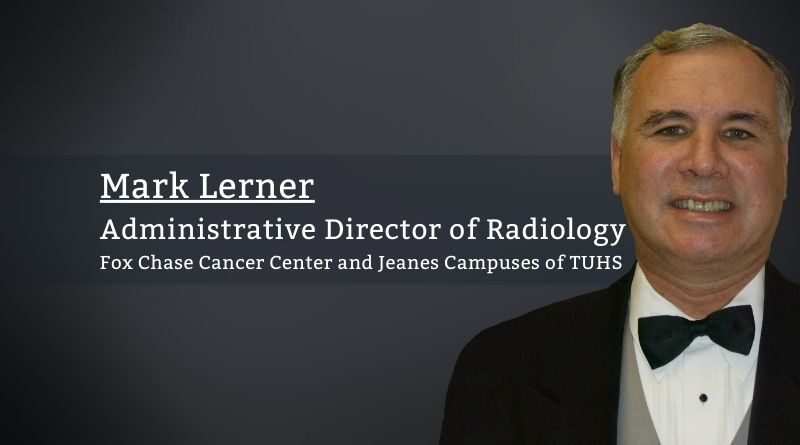Value-Based Customer Service Revisited
By Mark Lerner, Administrative Director of Radiology, Fox Chase Cancer Center and Jeanes Campuses of Temple University Health System
It was the year 2015, and my wife and I were in Lisbon, Portugal sitting down to eat in a restaurant located in an alleyway. It was a beautiful May evening. The weather was warm, and the sky was clear. The picturesque establishment was packed. It appeared that there were a hundred people gathered for dinner. You could not see an empty table. Our food arrived and I immediately knew I had a problem. I could not figure out how to eat one of the items on my plate, and there was only one waiter on duty taking care of guests. I had noticed him scurrying between tables in a mad rush earlier and now I required his attention. I felt terrible about having to disturb him. I called the waiter and immediately said I was sorry, but I needed help with my food. Without pausing for a second, the gentleman looked me in the eye and said, “Please don’t apologize to me, I may need your help one day.”
This event made a tremendous impression on me. For years I have vacationed in Europe and each time I was blown away by the tremendous level of customer service I routinely receive. Moreover, the kindness I experience seem much different to me than that I have come across in the United States. In America, we teach customer service. In countries such as Spain, Portugal, and Italy, it was clear that taking care of people is part of their being. It is inherent in them as individuals. The way they treat others is part of their values.
I always tell my technologists that you are going to take excellent care of patients anyway; why not tell them what to expect from the beginning.
I have spent more than thirty years working in healthcare, and raising the level of customer service has been a great area of interest. Frankly, I have struggled with how to accomplish this goal. For a decade, I taught service excellence to all new hospital employees. However, I found that the words just do not seem to stick with those in the audience. Our trip to Portugal completely changed my approach.
When I returned from overseas, I pulled my management team together and said that I wanted them to identify the values we would emphasize in our work with our patients. They identified eight: professionalism, dignity, empathy, kindness, respect, politeness, patience, and fun. I then put these together into a value-based customer service program that I had one of my managers roll out to the staff. We began discussing these values in all our meetings. I posted them on signs throughout the department. When someone was observed practicing these traits, we publicized the act to the other employees. If we found a co-worker falling short of these ideals, we addressed it immediately with them.
The outcome of initiating this program was amazing. The number of complaints the Radiology Department received from patients dwindled to almost nothing. The compliments started arriving in droves. I reported our effort to my senior leadership who were excited by the initiative.
There is an amazing side-effect from implementing a value-based customer service program. While the aim is to improve service to patients, once particular behaviors become socialized, you find people treating others in the department and throughout the hospital in the same manner. It becomes impossible to work in a particular manner with one group of individuals while using a different approach with others. The impact of our program far exceeded our original goal.
In seven years, I have learned much about this means of practicing customer service. For example, many in our field are familiar with the Studer Group’s use of the AIDET communication technique for providing patients with confidence in the care they are about to receive. Less well-known is that the organization added The Promise to AIDET. The Promise stands for exactly what it says it is. The staff introduces themselves to the patient, checks their identification, and then looks at them directly and states words to the effect of, “I’m going to take excellent care of you today.” Patients routinely react with one of the biggest smiles you will ever see on someone’s face. It makes sense. Patients are worried about what we are going to do to them in conducting our tests. They are even more concerned about the results. No one likes going for a medical appointment. The use of The Promise immediately puts the patient at ease. I always tell my technologists that you are going to take excellent care of patients anyway; why not tell them what to expect from the beginning.
The greatest use of the The Promise I have observed took place one day in my Women’s Center. A technologist came into the waiting room, identified herself, checked the patient’s armband for identification, thanked her for choosing our facility (thank you, the T in AIDET), and then stated she was going to take excellent care of her today. The patient was stunned. She immediately leaped out of her seat and exclaimed, “You know I really hate coming for my annual mammogram, but if you are going to take excellent care of me, let’s go!”
We have also used The Promise for service recovery. Supervisors can offer to patients, “I know things have not gone well for you up to now, but you are here with me and I’m going to take excellent care of you.”
The statement, “I am going to take excellent care of you today,” is actually full of values. I encouraged my staff to always utilize The Promise because it announced to patients that they were entering a value-based Radiology Department.
I now realize that the individual values selected for emphasis are not that important. Now I am a Radiology Administrator at Temple University Hospital. This organization’s values are respect, service, and quality. These sound good enough for me.



